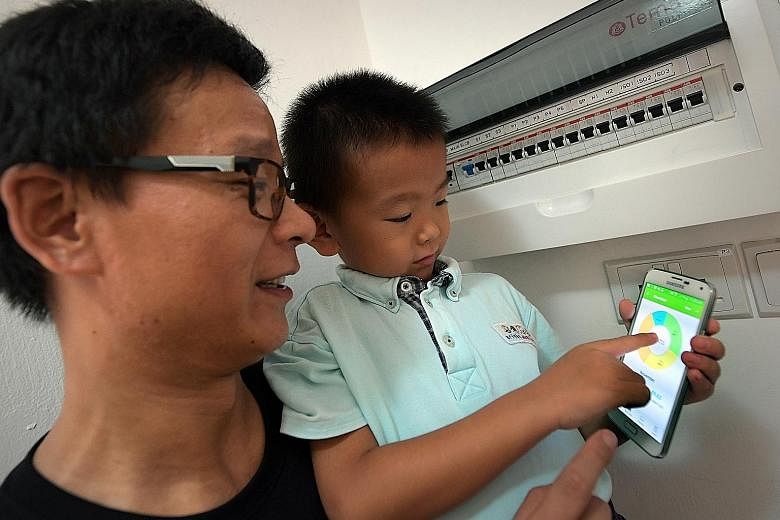The smart home of the future will not only allow people to track energy usage to save money, but it will also enable owners to keep an eye on old and young ones without the need for surveillance cameras.
Temasek Polytechnic (TP) and technology firm Smart DB have invented a way to determine where, when and how much electricity is being used by each appliance so as to save energy and monitor lifestyle habits. The Housing Board is working with TP to test it out in a mock-up flat.
"Should the trial results prove the 'Smart DB' feasible for wider implementation, it could be incorporated into HDB's smart-enabled flats in Punggol Northshore," said an HDB spokesman.
Such projects are part of a national drive to be a leader in all things smart. Last year, the HDB announced Singapore's first new public housing project, Punggol Northshore, which - when completed in 2020 - will come fitted with infrastructure that will enable it to test-bed smart technologies.
In April, Yuhua became the first estate to roll out smart home packages, such as one which monitors the use of energy and water and allows appliances to be switched on and off remotely.
-
Smart tech in HDB flats
-
September 2014
The "Smart HDB Town Framework", which maps out how smart initiatives will be introduced, is launched. Lab trials for smart-enabled homes, which look into areas such as utilities management and elderly care, are started.
May 2015
The first smart-enabled flats - Punggol Northshore - are put up for sale. When completed in 2020, they will tap smart technology for fans and lighting, as well as the carpark management system. These flats have proven to be popular with buyers, with flats in Northshore Residences I & II oversubscribed by 3.6 times.
April 2016
Following a trial, 3,200 households in Yuhua are offered the option to purchase smart home packages at discounted prices. This includes having sensors that can help monitor the well-being of the elderly and a mobile application that sends weekly updates on a household's electricity and water consumption.
July 2016
HDB inks a four-year collaboration with a consortium to develop a comprehensive digital masterplan to see how technology can be used to better maintain HDB estates. A Smart Hub, the "brain" for an HDB estate's operations, is also part of the plan. For instance, dashboards can be created to monitor and analyse the performance of key estate services such as lighting, pumps and waste collection.
September 2016
HDB announces that Tengah will be the first HDB town planned with smart technologies townwide from the outset. For instance, there will be simulation of the interaction of conditions such as wind flow, temperature fluctuations and solar irradiance and their impact on the surrounding urban landscape, such as buildings, water bodies or vegetation.
The TP system works by placing sensors into the electrical distribution board that every household has. Data from the sensors is transmitted to a mobile application.
For instance, by comparing how much power is being used by the kettle to boil water on different days, a person can tell whether the occupant is drinking more or less water than usual. The app taps an algorithm to convert energy data from the kettle into volume or litres of water consumed.
By isolating the timing and use of electricity to the fridge, water heater, air-conditioning or lights, home owners will also be able to tell what time their charges go to bed or wake up, how many times a person showers or watches television, as well as how long the computer is being used.
"This is useful in two ways. First, if elderly persons live alone or the kids are by themselves at home, the caregiver can check if there are prolonged periods of non-activity and check in on them for their safety," said Dr Kwan Kian Hoong, section head of TP's Clean Energy Research Centre.
"Second, if there is any significant deviation in behaviour, such as the old person not getting enough sleep or water, or the children spending too much time at the television or computer, the caregiver can also be alerted."
Knowing which appliance eats up the most power also helps users to plan and cut down their energy consumption as well as replace non- energy efficient appliances.
This first-of-its-kind system for residential units is being piloted both at the HDB mock-up flat and a staff apartment on TP's campus. Its patent is pending approval. "In comparison with existing home energy monitoring solutions commonly found in the market, the 'Smart DB' does not require the use of additional devices, such as energy clamps or smart plugs, to monitor energy usage," said the HDB spokesman.
Development of the TP project started in 2013 when it received funding from the Ministry of Education Translational and Innovation Fund. The hardware is estimated to cost a few hundred dollars for a four- to five-room flat.
Mr Bai Zemin, 36, a research officer at TP's School of Applied Science who lives with a six-year-old son in the apartment where the system is being tested, said he found it useful.
"When my 64-year-old elderly mother came over from China to visit me for a month, I could keep tabs on her. My son also often forgets to switch off the lights but with the system, we can check specifically which lights are still on," he said.
TP intends to use the system in its labs and offices next, to track energy usage and unauthorised access. It is also adapting the technology for industrial settings to manage energy and monitor productivity.
Said Dr Kwan: "Nowadays, many people are wearing fitness bands to track their fitness. In future, we hope to see every household also using such technology to live more effectively."


